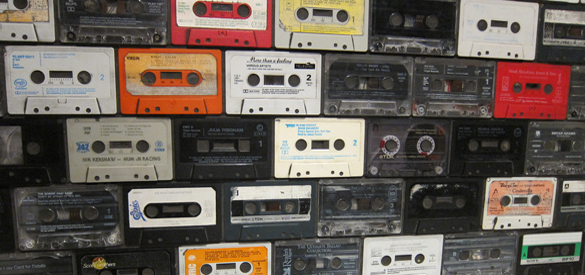| Sun | Mon | Tue | Wed | Thu | Fri | Sat |
|---|---|---|---|---|---|---|
| 1 | 2 | 3 | 4 | 5 | ||
| 6 | 7 | 8 | 9 | 10 | 11 | 12 |
| 13 | 14 | 15 | 16 | 17 | 18 | 19 |
| 20 | 21 | 22 | 23 | 24 | 25 | 26 |
| 27 | 28 | 29 | 30 | 31 |
CATEGORIES
RECENT ENTRIES
BLOG ROLL
Signal to noise
In defense of the cassette tape.
By Carrie Golus, AB'91, AM'93

Readers of a certain age, perhaps you, like me, still have a small selection of cassette tapes in your possession, which you hang onto for sentimental reasons. Mine are from high school (U2, Under a Blood Red Sky) and the period between college and graduate school, when I was traveling (Nirvana, Nevermind, and Sugar, Copper Blue). Not to mention the mixtapes made for me by random boys trying to improve my musical tastes, and their chances.
Ah, cassettes. Getting caught in the spools of your cassette player. Melting if you forgot them in the car on a hot day. Forcing you to rewind or fast-forward if you disliked a particular song. And distorting if you rewound or fast-forwarded them too much.
For years, these plastic leftovers have seemed ancient and a little embarrassing—the inferior products of an inferior age. No more. Cassette owners of the world, rise up, for tapes have become trendy—even though they were never particularly trendy before. Eric Hanss, ’11, who serves as program manager of WHPK and runs his own cassette-tape label, Field Studies, explains.
Defend the cassette to me.
All right.
The cassette is great on a lot of different fronts. For people in the do-it-yourself, underground music scene, there is a long historical usage of cassettes as a revolutionary medium, going back to the late 1970s. When people couldn’t afford to press LPs, they’d use cassettes.
A lot of experimental and underground music and noise has been on cassettes for forever. So people see a cassette and there’s instantly a connection with an earlier time. There’s a grad student in the anthropology department [Brian Horne, AM'04] who’s writing his dissertation on folk music that was banned in the Soviet Union. These tapes were dubbed and dubbed and dubbed, to the point where you couldn’t hear anything on the tape at all. You’d have a 12th-generation tape circulating. But everyone already knew the lyrics, so the point was moot. What you could hear is every single person in the chain being in contact with you.

Cassettes make great art objects. They’re substantial. They’re the perfect size for really cool, small-scale graphic designs. They’re also the perfect size to trade with people or just give to someone. It feels good to have a cassette in your hand. Cassettes are so cheap that you can sell a cassette on tour for $5 and make some money to get to the next town. A cassette is the price of a beer at a club, so it makes a lot of sense.
And then personally, I really like the sonic aspect of them. The lows are boosted, the highs are clipped. There’s a noise floor, the cassette hiss, so instead of having a clean stereo space, there’s something different and weird going on. There’s a space to the medium itself that it imposes on the music.
So that’s why I really like cassettes. For the past couple years I’ve done mostly cassette-only shows.
Really?
Yeah. For the past year, more and more DJs have been bringing cassettes. A lot of music that’s really great, that really fits in with the do-it-yourself punk-rock thing that we have going on at WHPK, is starting to be only released on cassette.
What kind of music do you release?
Field Studies releases underground experimental sound that engages with the broad concept of imagined space or spaces. Much of the music could be classified as drone, meditation music, inner journeys, or sound art. I’m primarily interested in non-narrative music that provides a tableau on which the listener can project their imagination or engage with the sonic space of the content.
When did you get started?
The very first Field Studies release came out in the summer of 2009 as a benefit tape. The label has only been highly active since the fall of 2010. I’ve put out five cassettes and one CD-R since then. I have six slated for release in late May and late June.
How many bands are on your label?
I’ve done releases by eight different performers/groups so far: Astronaut, Faceworker, Cloaked Light, White Prism, 56K, Slag Heap, Lunar Miasma, and Quicksails. I have releases coming from Bil Vermette, Brett Naucke, Panabrite, Agnes, Dolphins into the Future, and Ultradome.
There are no bands “on” Field Studies, save perhaps Floating Gardens, which is my solo project. I am currently weighing how I would like to handle repeat appearances by the artists on Field Studies, if at all. Many artists have multiple recording aliases that are each a different facet of that individual’s output, or they play in different combos with other performers.
Many cassette labels are not run in the same way conventional labels are. Every single artist I’ve worked with thus far (and all of the artists I’m currently working with) runs their own label. Most agreements are done by word of mouth. The New Age scene is especially close knit, so this process generally involves asking friends or new acquaintances if they would be interested in doing a tape. There are no contracts. Field Studies operates in this way.
Is this something you plan on doing for the long term?
I plan to release cassettes for the long term under the no-profit business model. Whether that is with Field Studies, I don’t know.
Like many other cassette labels, Field Studies is designed under a specific mission. I currently have projects for two sub-labels in the works, as I’m afraid that Field Studies is falling into a trap that I’ve seen other labels fall into. I’m personally not interested in running Field Studies as a standard label with increasingly active promotion and visibility. While I do want the artists I work with to succeed and reach broader audiences, I don’t want cassettes to become generic commodities.
The sub-labels allow me to work creatively with the idea of what a label identity is.
How many copies of recordings have you sold, and for how much per cassette?
Every release is printed in an edition of 45-100. I have 25 copies total remaining from my last two batches. The retail price for each cassette is $7, but some are sold at lower distribution prices to record stores, while many others are traded, given away, or sold at live shows for less. All told, 500 have passed through my hands in one way or another.
June 3, 2011
